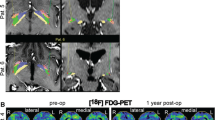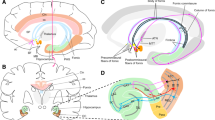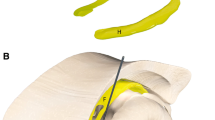Abstract
The next several decades will see an exponential rise in the number of patients with disorders of memory and cognition, and of Alzheimer’s disease in particular. Impending demographic shifts, an absence of effective treatments, and the significant burden these conditions place on patients, caregivers, and society, mean there is an urgent need to develop novel therapies. Deep brain stimulation (DBS) is a neurosurgical procedure that is a standard-of-care for many patients with treatment-refractory Parkinson’s disease, dystonia, and essential tremor. DBS has proven to be an effective means of modulating activity in disrupted motor circuitry, and has shown promise as a modulator of other dysfunctional circuits, including for mood and anxiety disorders. The deficits in Alzheimer’s disease and other disorders of memory and cognition are also beginning to be thought of as arising from dysfunction in neural circuits. Such dysfunction may be amenable to modulation using focal brain stimulation. A global experience is now emerging for the use of DBS for these conditions, targeting key nodes in the memory circuit, including the fornix and nucleus basalis of Meynert. Such work holds promise as a novel therapeutic approach for one of medicine’s most urgent priorities.


Similar content being viewed by others
References
Reitz C, Brayne C, Mayeux R. Epidemiology of Alzheimer disease. Nat Rev Neurol 2011;7:137-152.
Hely MA, Reid WG, Adena MA, Halliday GM, Morris JG. The Sydney multicenter study of Parkinson's disease: the inevitability of dementia at 20 years. Mov Disord 2008;23:837-844.
Kowal SL, Dall TM, Chakrabarti R, Storm MV, Jain A. The current and projected economic burden of Parkinson's disease in the United States. Move Disord 2013;28:311-318.
Bronstein JM, Tagliati M, Alterman RL, et al. Deep brain stimulation for Parkinson disease: an expert consensus and review of key issues. Arch Neurol 2011;68:165.
Flora ED, Perera CL, Cameron AL, Maddern GJ. Deep brain stimulation for essential tremor: a systematic review. Move Disord 2010;25:1550-1559.
Bronte-Stewart H, Taira T, Valldeoriola F, et al. Inclusion and exclusion criteria for DBS in dystonia. Move Disord 2011;26(Suppl. 1):S5-16.
Mayberg HS, Lozano AM, Voon V, et al. Deep brain stimulation for treatment-resistant depression. Neuron 2005;45:651-660.
Nuttin B, Cosyns P, Demeulemeester H, Gybels J, Meyerson B. Electrical stimulation in anterior limbs of internal capsules in patients with obsessive-compulsive disorder. Lancet 1999;354:1526.
Lipsman N, Woodside DB, Giacobbe P, et al. Subcallosal cingulate deep brain stimulation for treatment-refractory anorexia nervosa: a phase 1 pilot trial. Lancet 2013;381:1361-1370.
Ponce FA, Lozano AM. Deep brain stimulation state of the art and novel stimulation targets. Prog Brain Res 2010;184:311-324.
Deep brain stimulation for movement disorders: products and procedures. Available at: http://professional.medtronic.com/pt/neuro/dbs-md/prod/. Accessed March 23, 2014.
Seeley WW, Crawford RK, Zhou J, Miller BL, Greicius MD. Neurodegenerative diseases target large-scale human brain networks. Neuron 2009;62:42-52.
Sperling RA, Dickerson BC, Pihlajamaki M, et al. Functional alterations in memory networks in early Alzheimer's disease. Neuromolecular Med 2010;12:27-43.
Kringelbach ML, Jenkinson N, Owen SL, Aziz TZ. Translational principles of deep brain stimulation. Nat Rev Neurosci 2007;8:623-635.
Lozano AM, Lipsman N. Probing and regulating dysfunctional circuits using deep brain stimulation. Neuron 2013;77:406-424.
Lee KH, Chang SY, Roberts DW, Kim U. Neurotransmitter release from high-frequency stimulation of the subthalamic nucleus. J Neurosurg 2004;101:511-517.
McIntyre CC, Savasta M, Kerkerian-Le Goff L, Vitek JL. Uncovering the mechanism(s) of action of deep brain stimulation: activation, inhibition, or both. Clin Neurophysiol 2004;115:1239-1248.
McIntyre CC, Hahn PJ. Network perspectives on the mechanisms of deep brain stimulation. Neurobiol Dis 2010;38:329-337.
Turnbull IM, McGeer PL, Beattie L, Calne D, Pate B. Stimulation of the basal nucleus of Meynert in senile dementia of Alzheimer's type. A preliminary report. Applied Neurophysiology 1985;48:216-221.
Freund HJ, Kuhn J, Lenartz D, et al. Cognitive functions in a patient with Parkinson-dementia syndrome undergoing deep brain stimulation. Arch Neurol 2009;66:781-785.
Laxton AW, Tang-Wai DF, McAndrews MP, et al. A phase I trial of deep brain stimulation of memory circuits in Alzheimer's disease. Ann Neurol 2010;68:521-534.
Fontaine D, Deudon A, Lemaire JJ, et al. Symptomatic treatment of memory decline in Alzheimer's disease by deep brain stimulation: a feasibility study. J Alzheimers Dis 2013;34:315-323.
Thomas AG, Koumellis P, Dineen RA. The fornix in health and disease: an imaging review. Radiographics 2011;31:1107-1121.
Hamani C, McAndrews MP, Cohn M, et al. Memory enhancement induced by hypothalamic/fornix deep brain stimulation. Ann Neurol 2008;63:119-123.
Parent A. Limbic system. In: Parent A (ed.) Carpenter's human neuroanatomy. 9th ed. Williams & Wilkins, Baltimore, MD, 1996, pp. 744-794.
Rosen WG, Mohs RC, Davis KL. A new rating scale for Alzheimer's disease. Am J Psychiatry 1984;141:1356-1364.
Smith GS, Laxton AW, Tang-Wai DF, et al. Increased cerebral metabolism after 1 year of deep brain stimulation in Alzheimer disease. Arch Neurol 2012;69:1141-1148.
ADvance DBS-f in Patients With Mild Probable Alzheimer's Disease. Available at: http://clinicaltrials.gov/ct2/show/study/NCT01608061. Accessed March 25, 2014.
Koubeissi MZ, Kahriman E, Syed TU, Miller J, Durand DM. Low-frequency electrical stimulation of a fiber tract in temporal lobe epilepsy. Ann Neurol 2013 Apr 24 [Epub ahead of print].
Mesulam MM, Mufson EJ, Levey AI, Wainer BH. Cholinergic innervation of cortex by the basal forebrain: cytochemistry and cortical connections of the septal area, diagonal band nuclei, nucleus basalis (substantia innominata), and hypothalamus in the rhesus monkey. J Comp Neurol 1983;214:170-197.
Croxson PL, Kyriazis DA, Baxter MG. Cholinergic modulation of a specific memory function of prefrontal cortex. Nat Neurosci 2011;14:1510-1512.
Gratwicke J, Kahan J, Zrinzo L, et al. The nucleus basalis of Meynert: a new target for deep brain stimulation in dementia? Neurosci Biobehav Rev 2013;37:2676-2688.
Hanyu H, Asano T, Sakurai H, Tanaka Y, Takasaki M, Abe K. MR analysis of the substantia innominata in normal aging, Alzheimer disease, and other types of dementia. AJNR Am J Neuroradiol 2002;23:27-32.
Choi SH, Jung TM, Lee JE, Lee SK, Sohn YH, Lee PH. Volumetric analysis of the substantia innominata in patients with Parkinson's disease according to cognitive status. Neurobiol Aging 2012;33:1265-1272.
Lee JE, Cho KH, Song SK, et al. Exploratory analysis of neuropsychological and neuroanatomical correlates of progressive mild cognitive impairment in Parkinson's disease. J Neurol Neurosurg Psychiatry 2014;85:7-16.
Birks J. Cholinesterase inhibitors for Alzheimer's disease. Cochrane Database Syst Rev 2006:CD005593.
Hardenacke K, Shubina E, Buhrle CP, et al. Deep brain stimulation as a tool for improving cognitive functioning in Alzheimer's dementia: a systematic review. Front Psychiatry 2013;4:159.
Barnikol TT, Pawelczyk NB, Barnikol UB, et al. Changes in apraxia after deep brain stimulation of the nucleus basalis Meynert in a patient with Parkinson dementia syndrome. Move Disord 2010;25:1519-1520.
Hardenacke K, Kuhn J, Lenartz D, et al. Stimulate or degenerate: deep brain stimulation of the nucleus basalis Meynert in Alzheimer dementia. World Neurosurg 2013;80:S27 e35-43.
Bliss TV, Lomo T. Long-lasting potentiation of synaptic transmission in the dentate area of the anaesthetized rabbit following stimulation of the perforant path. J Physiol 1973;232:331-356.
Ehret A, Haaf A, Jeltsch H, Heimrich B, Feuerstein TJ, Jackisch R. Modulation of electrically evoked acetylcholine release in cultured rat septal neurones. J Neurochem 2001;76:555-564.
Williams JM, Givens B. Stimulation-induced reset of hippocampal theta in the freely performing rat. Hippocampus 2003;13:109-116.
Halgren E, Wilson CL. Recall deficits produced by afterdischarges in the human hippocampal formation and amygdala. Electroencephalogr Clin Neurophysiol 1985;61:375-380.
Lacruz ME, Valentin A, Seoane JJ, Morris RG, Selway RP, Alarcon G. Single pulse electrical stimulation of the hippocampus is sufficient to impair human episodic memory. Neuroscience 2010;170:623-632.
Suthana N, Haneef Z, Stern J, et al. Memory enhancement and deep-brain stimulation of the entorhinal area. N Engl J Med 2012;366:502-510.
Braak H, Braak E. Neurofibrillary changes confined to the entorhinal region and an abundance of cortical amyloid in cases of presenile and senile dementia. Acta Neuropathol 1990;80:479-486.
Stranahan AM, Mattson MP. Selective vulnerability of neurons in layer II of the entorhinal cortex during aging and Alzheimer's disease. Neural Plast 2010;2010:108190.
Fell J, Staresina BP, Do Lam AT, et al. Memory modulation by weak synchronous deep brain stimulation: a pilot study. Brain Stimul 2013;6:270-273.
Toda H, Hamani C, Fawcett AP, Hutchison WD, Lozano AM. The regulation of adult rodent hippocampal neurogenesis by deep brain stimulation. J Neurosurg 2008;108:132-138.
Hamani C, Stone SS, Garten A, Lozano AM, Winocur G. Memory rescue and enhanced neurogenesis following electrical stimulation of the anterior thalamus in rats treated with corticosterone. Exp Neurol 2011;232:100-104.
Stone SS, Teixeira CM, Devito LM, et al. Stimulation of entorhinal cortex promotes adult neurogenesis and facilitates spatial memory. J Neurosci 2011;31:13469-13484.
Acknowledgments
A.M.L. is a Canada Research Chair in Neuroscience and is supported by the R.R. Tasker Chair in Functional Neurosurgery. Additional support was provided by the Dana Foundation and Krembil Neuroscience Discovery Fund. A.M.L. is a consultant to Medtronic, St Jude, and Boston Scientific. A.M.L. serves on the scientific advisory board of Ceregene, Codman, Neurophage, Aleva and Alcyone Life Sciences. A.M.L. is co-founder of Functional Neuromodulation Inc. and holds intellectual property in the field of deep brain stimulation. All other authors declare no relevant conflicts of interest.
Required Author Forms
Disclosure forms provided by the authors are available with the online version of this article.
Author information
Authors and Affiliations
Corresponding author
Electronic supplementary material
Below is the link to the electronic supplementary material.
ESM 1
(PDF 1225 kb)
Rights and permissions
About this article
Cite this article
Sankar, T., Lipsman, N. & Lozano, A.M. Deep Brain Stimulation for Disorders of Memory and Cognition. Neurotherapeutics 11, 527–534 (2014). https://doi.org/10.1007/s13311-014-0275-0
Published:
Issue Date:
DOI: https://doi.org/10.1007/s13311-014-0275-0




